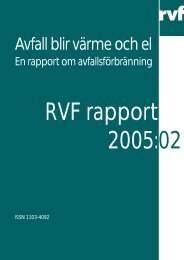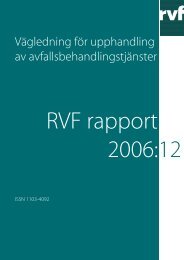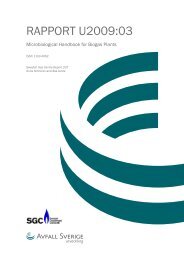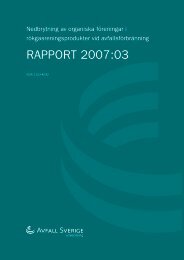SwediSh waSte management |2011 - Avfall Sverige
SwediSh waSte management |2011 - Avfall Sverige
SwediSh waSte management |2011 - Avfall Sverige
You also want an ePaper? Increase the reach of your titles
YUMPU automatically turns print PDFs into web optimized ePapers that Google loves.
Swedish waste <strong>management</strong> 2011Another collection system that is on the riseis the underground container system. Placinglarger containers underground reduces theneed for space on street level. The temperaturebelow street level, where the waste iscontained, is relatively low, which preventsodor, and the containers are easily emptiedwith a hook lift vehicle. There are also undergroundcontainers that are emptied with frontloadingvehicles. Since the underground containerscarry larger volumes, the number oftransports can be reduced.At the municipalities’ manned recyclingcenters, the households themselves drop offbulky waste, electronic waste and hazardouswaste. Bulky waste is household waste, whichis too heavy, too bulky or for other reasonsinappropriate for collection in bags or bins. In2010, households dropped off 1.5 million tonsof bulky waste, most of which was handed tothe manned municipal recycling centers. Asmaller part, about ten percent, was collectedthrough curbside collection. The bulky wastevolumes correspond to 161 kg per person.There are about 600 recycling centers throughoutthe country, and in total they receive about20 million visits annually.The volumes of bulky waste and hazardouswaste that are handed to the recycling centershave increased significantly in recent years.Several municipalities have therefore adaptedand modernized their recycling centers.Smaller recycling centers are typically closedwhen the municipalities build new, larger centersbetter-suited to the waste quantities andnumber of visitors.Several recycling centers in Sweden havehad severe problems with burglaries andthefts in recent years, as well as incidentswhen staff have been personally threatened.Most of the larger modern recycling centershave therefore installed electric fences, whichhave considerably reduced the number ofbreak-ins. In order to improve safety, and forthe sake of a functional system for accesscontrol that would enable more accurate visitorstatistics, several of the municipalities alsointroduced a barrier gate system at the recyclingcenters. This system is often combinedwith an entry card which allows households toa certain number of free visits. Small businessowners may also use the services offered atthe recycling centers in several of the municipalitiesfor a fee.The producers’ system includes approximately5,800 unmanned recycling stations forpackaging and newspaper that cover theentire country. The collection systems shouldbe formed in consultation with both producersand local authorities. The recycling stationshave separate bins for newspaper and variouspackaging material.A growing number of municipalities areimplementing curbside collection of packagingand newspaper from apartment blocks andsingle-family homes.According to a survey by <strong>Avfall</strong> <strong>Sverige</strong> –Swedish Waste Management 2 , about 60 percentof what households place in trash bagscan be recycled and in households that do notsort food waste the figure is almost 80 percent,.The survey has compiled 246 Waste-Analyses carried out in Sweden’s municipalitiessince 2007. Single-family homes are generallybetter at sorting out recyclable materials;about 20 percent of their household wasteconsists of packaging and newspapers. Inapartment households this figure is 36 percent.One half percent of the waste is hazardouswaste, batteries and waste from electricaland electronic equipment (WEEE).The system chosen for collection alsoaffects the degree of sorting. Single-familyhomes with curbside collection, source separatethe waste most effectively, with half theamount of packaging and paper in the trashcompared to other households.2 U2011:04 National survey of random analyses of household bins and bags of waste7

















